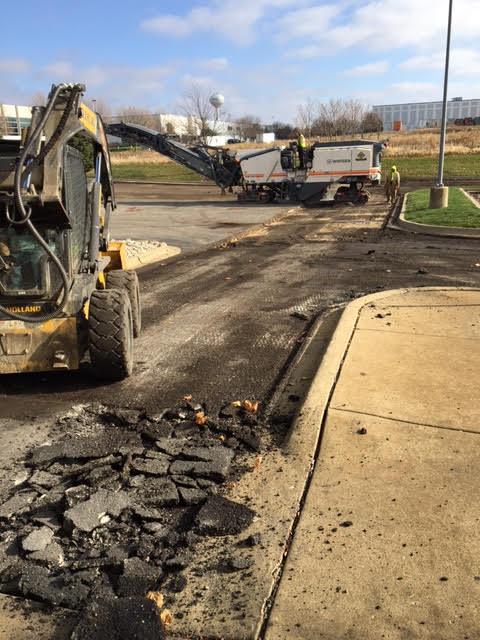An asphalt overlay consists of one or more layers of fresh asphalt that a paving contractor installs on top of an existing pavement. When the existing pavement is asphalt, contractors typically refer to the procedure as asphalt resurfacing. As part of the resurfacing procedure, most contractors will use a milling machine to help ensure high-quality results.
What Is an Asphalt Milling Machine?
An asphalt milling machine is a type of construction equipment with a rotating drum that has carbide cutters attached. The operator sets the machine to remove a precise depth of the asphalt pavement, and the machine grinds it away. The removed pavement then moves automatically onto an attached conveyor for recycling, typically at an asphalt plant.
What Are the Advantages of Asphalt Resurfacing?
Asphalt pavement resurfacing is substantially less expensive than removing and replacing one, but the results are almost identical. Resurfacing is also faster, so you can reopen your pavement sooner, reducing any inconvenience to your visitors or employees. Because the milled asphalt is completely recyclable, resurfacing is an eco-friendly option. Furthermore, as long as you protect the structural integrity of your pavement, you can repeat the asphalt overlay process as often as needed. Thus, you could theoretically go many decades without ever requiring a complete pavement reconstruction.
Why Do Contractors Use Milling Machines During Asphalt Resurfacing Projects?
When resurfacing pavement, a contractor must perform a series of steps to achieve satisfactory results. Contractors virtually always use a milling machine as part of an asphalt overlay process for all of the following reasons.
1. Speed: Asphalt milling is much faster than removing the existing pavement with traditional methods. This can speed up your job, which means that the contractor may be able to charge less for your asphalt overlaying project.
2. Repair: Overlaying asphalt pavements that have potholes or significant cracks is simply unacceptable to a reputable contractor. The damage pattern will soon begin to show up in the overlay. If the contractor must repair numerous breaks in the pavement, your cost will increase. However, on most pavement resurfacing projects, contractors remove between two and three inches of the existing pavement. This is often sufficient to remove all or most of the damage. It also exposes any damage that goes deeper, making it easier for your contractor to repair it.
3. Elevation: If you examine your pavement, you will probably see that it is not an isolated, unbroken expanse. There will be other pavements that connect to it, including driveways, curb ramps, and streets. There are usually curbs, catch basins, gutters, manhole covers, and other features. Imagine what would happen if your contractor installed two or three inches of fresh asphalt on top of your existing pavement without milling it first. You would be left with rough transitions between pavements, presenting potential tripping hazards to pedestrians and annoying drivers. Manhole covers and drain grates would be recessed into the pavement. The ability of your gutters and curbs to channel runoff would be reduced. You expected a renovated pavement that looked and functioned like a new one. Instead, you have a pavement that clearly shows that your contractor did a poor job on your pavement resurfacing project.
Black Hawk Paving is a full-service asphalt paving company serving the greater Chicagoland area. Our services include asphalt milling, parking lot striping, asphalt overlaying and paving, hot crack sealing, asphalt repairs, concrete installation, asphalt sealcoating, and concrete repairs. We serve national clients as well as local businesses. We have an exemplary reputation, decades of experience, and the ability to handle all phases of construction from site grading to pavement markings. Submit our online form if you are interested in requesting a free quote. If you prefer to call us, you can reach us at 708-479-0400.


